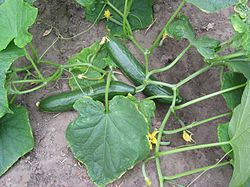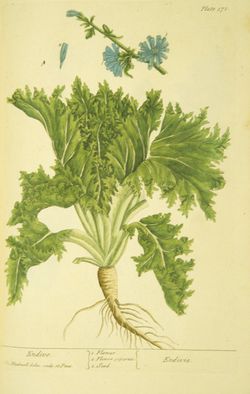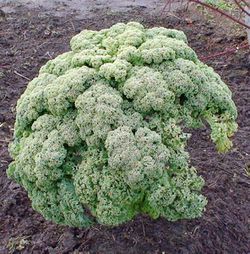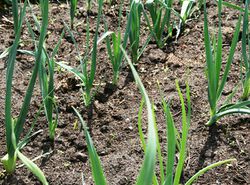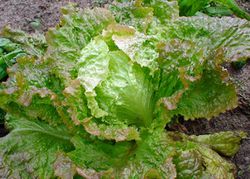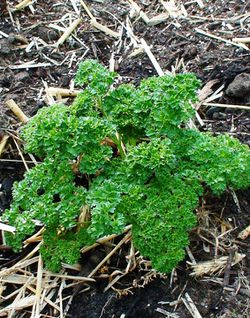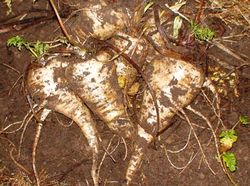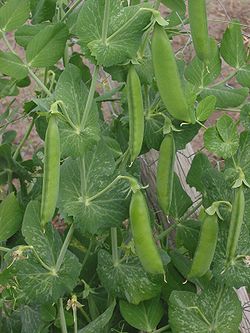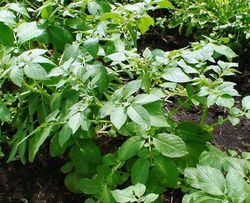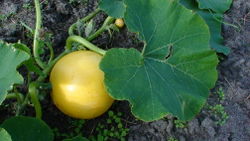Good crops for the beginning gardener
- This page is under construction - JE
Beans
- Main article Bean (Phaseolus vulgaris)
Only sow when there's no danger anymore for frost or night frost. For the region where i have my garden (temperate climate, northern hemisphere) this is after May 15. You can sow until half July, depending on the species. Don't add fresh manure to the soil, but beans like a humus-rich soil so you can add some old compost or saw dust to prevent the beans from rotting.
Beans like full sun and dislike cold and wet weather.
Sow the beans 7 per stick or group of plants and keep the five best of them. Cover the seeds with ca 2 cm of moist soil.
Beans growing onto sticks: You may need to help the beans fix to the stick with little ropes. The bean twiners coil anti-clockwise, seen from above.
Pick those beans that are big enough. Picking the beans stimulates the growth of more beans.
Beetroot
- Main article Beetroot
You can sow beetroot directly into the soil. It helps to put the seeds a few days in water to make them germinate faster. You can also sow beets in pots and then plant them out, but because beets have taproots you cannot keep them long in pots. Thin the beets at 15 cm in the row.
Desired pH = 6-6.5 (a bit acid).
Beetroots need to grow in the full sun and don't tolerate shade.
They don't appreciate a lot of nitrogen fertilizer, so don't give them too much compost. However, they do like some potassium added.
Lettuce is a good companion plant for beetroot.
For winter storage harvest beetroot before it begins to freeze. Twist off the foliage with your hands, don't cut it with a knife. When you cut beetroot stems with a knife, the juices in the turnip will bleed out, and not when you twist them off with your hands.
Carrot
- Main article Carrot
Carrots like any soil but rocks will deform them. They also don't like and don't need compost or manure. I always sow them in a field that was composted the year before and where another crop has grown on that compost. They grow well even in soils that are so poor that most other crops won't develop.
Sow summer carrots from February to the end of June. Winter carrots from March to May. Add wet sand to the seeds and keep them a few days like this, then sow the seeds together with the sand. The sand helps you sow regularly and the moist seeds germinate faster. Sow ca 2 cm deep. To find back the line (carrots grow very slowly during the first month or so), you can add some radish seed. I usually plant bulb onions in the lines, each one or two hand widths an onion. This also shows the line and it prevents carrot flies from damaging your crop.
After a few weeks you need to thin the small plants; give winter carrots a bit more space.
Carrots are said to be useful companion plants for tomatoes as they increase tomato production. I haven't tried this out yet.
Carrots grow best in full sun but tolerate some shade.
Carrots tolerate some frost. I usually keep them outside under a sheath of hay until it begins to freeze continually. Dig them out and store the roots without the leaves covered with clean sand in a box in a cellar or other cool place.
Celery
- Main article Celery
The celery of which the leaves are used, leaf celery, is sown in spring in March and later again in September. I usually sow in pots and plant them out later. You can also mix the seeds with moist sand and let them start to germinate before sowing outside. In September you can sow in pots or under glass. You can actually sow through the entire summer, but the plants won't become as big as those sown in March.
Spring celery can be harvested in August-September. Autumn celery from February to April. Cut or pick leaf celery when they are about 15 cm high, but don't cut out the heart so you can harvest again.
Celery root can be pre-sown from February to April and planted out in May and June. Celery root needs longer time to grow and likes a fertile soil.
In the past, celery was grown as a vegetable for winter and early spring. It was perceived as a cleansing tonic. It is used in some weight-loss diets where it provides low-calorie fibers.
Celery is also grown for its seeds. The volatile oil is used in the perfume and pharmaceutical industries. Celery seeds, whole or ground, can be used to season dishes.
Cucumber
- Main article Cucumber
The cucumber originates in India but is now grown around the world. Depending on the cultivar you can grow them in a greenhouse, a cold frame or outside. In April you can sow inside, in May until June 21 also outside.
Cucumbers like humus-rich soil and ample compost. A temperature of 70 F (21 C) when the plant grows up gives stronger plants and better results.
Most varieties have seeds. Male and female flowers grow at the same plant and pollination is required. Professional growers bring hives with honey bees to the fields. If you have too few insects in your own garden you can grow bee plants or spray sugar water to attract them.
Water the plants well. Cucumbers need much water and in dry circumstances the fruits get bitter.
Squeeze off the top after the fourth leaf and the branches again after the third leaf. This stimulates the plant to give more fruits. Harvest them when they are young. This stimulates the plant to form new flowers.
Endive
- Main article Endive
Endive is a member of the chicory genus, of which the leaves are often bitter. You can sow them in March under glass and plant them out in May, or sow outside after June 21 for winter harvest. During the first month of growth, endive should not be exposed to temperatures below 50 F (10 C) or the plants will soon make flowers instead of nice green heads. Seeds sown after June 21 won't make flowers anymore.
The green leaves are rich in vitamin A and C and minerals and can be cooked or used raw in salads. Some gardeners bleach the center leaves by putting a flower pot upside down on the plants a few weeks before harvesting.
Let one or two plants stand to make flowers. You cannot eat these plants but the blue flowers are beautiful.
Fava bean
- Main article Fava bean
Sow fava beans (also called broad beans) in February and March. You can also sow under glass already in late autumn or January. Fava beans can overwinter.
Don't add manure to the soil but some old compost is ok, or sawdust to prevent the beans from rotting. Sow some dill in the same row, they protect against blackfly. Another method against blackfly is to pinch out the tops when the plant begins to blossom. You can stir-fry these tops and they are delicious.
Plant distance in the row 15 cm and between the rows 60 cm. Harvest is from mid June to July. You can grow lettuce between the beans when they are still small.
Fava beans grow in any soil but prefer rich loams. As a legume, they live in a symbiosis with Rhizobium, soil bacteria that fix nitrogen.
Broad beans are an old vegetable and were already eaten in the Mediterranean around 6000 BCE or earlier. Fava beans are often flavored with savory.
Gherkin
- Main article Gherkin
Gherkins and commercial cucumbers belong to the same species (Cucumis sativus), but are from different cultivar groups.
You sow gherkins in May and June. Sow in a cold frame, in pots or in a greenhouse, or outside from the end of May. Sow 3 seeds together and keep the strongest. Gherkins needs full sun and a humus-rich fertile soil.
Pinch off the top above the fourth leaf and from the side branches the tops after the third leaves. This increases the production of fruits.
Make sure that pollination takes place, normally by bees. You can spray sugar water to attract bees. You can also use a brush to bring pollen from the male flowers into the female ones.
Harvest is from July to October. By harvesting the young gherkins the plants will produce more fruits. You can conserve gherkins in vinegar and add sugar, honey and various herbs.
Kale
- Main article Kale
Kale was one of the most common vegetables in Europe already before the Middle Ages. Some varieties existed in ancient Greece.
Kale is an easy crop to cultivate and grows on most every soil. Sow preferably in April, not later than the end of June. You can sow in a row, or in pots, and plant out later.
Kale can tolerate shade quite well. You can plant them between crops that are going to be harvested in the summer. By the time that the kale plants get bigger, the other crops will be gone.
Kale tastes best when frost has been over it. If you harvest before it froze outside, you can freeze kale in the freezer. Kale usually withstands the hardest winters, although some leaves may be damaged by stronger frost. Kale grows out again in early spring until it begins to blossom around April. Let the plants flower for some time; bees like it.
Kale is very high in a number of vitamins, among them vitamin C. and is reasonably rich in calcium. Kale, contains sulforaphane, a chemical with potent anti-cancer properties. Boiling decreases the level of sulforaphane[1]; however, steaming, microwaving, or stir frying do not result in significant loss.[2]
Leek
- Main article Leek
Leek, according to some researchers, was already part of the the Egyptian and Mesopotamian diet at least from the 2nd millennium BCE onwards.
Fertilize your soil well with compost. Sow summer leek plants from January to April inside in a shallow box or in a row in greenhouse or in a cold frame. Sow winter leek from March to the first half of May in the same way. You can also sow directly in the soil, this gives you less trouble with the leek fly.
Transplant when the plants are as thick as a pencil. Make trenches of 20 cm deep and plant leek in these trenches. You can also plant in holes made with the backside of the stick of one of your garden tools. You can hill up the plants as they grow but prevent soil from coming between the leaves.
You can also plant them in a normal way, that is not in trenches or holes. I did this with the summer leek shown in the photo (taken in June).
You can harvest summer leek from June to the end of autumn and winter leek from early autumn until the next spring. The winter leek species are hardy.
Lettuce
- Main article Lettuce
Lettuce belongs to the aster or sunflower family. It has nice little yellow flowers when you let it blossom. Lettuce was first cultivated by the Egyptians and later by the Greeks and Romans. More varieties were developed in Europe from the 16th to the 18th century and these lettuce cultivars can still be found in gardens.
I grow lettuce the entire year through. You can sow from March to October. From April to August you can sow directly in the soil outside, but in the season i always sow some lettuce seeds in a pot every two weeks. When seedlings are about an inch tall they are planted single in pots and after about one month planted out in the garden. I plant them on places where other crops have grown. In this way you can have fresh salad every day, with little effort and minimal costs.
I overwinter some plants in the greenhouse and when the winter is not too cold, they easily survive and give harvest in late autumn or in early spring. Lettuce tolerates some night frost but not enduring frost.
The summer crop is sensitive to shooting (forming flowers) when the weather is too hot and dry.
Sow in moist, fertile soil but you don't give new compost to the soil where you plant lettuce. When the weather is hot make sure that you water them well. I often plant lettuce between pole beans. In that way they get enough shade and they fill up the space that otherwise could not be used. Don't plant lettuce to deep as the leaves will rot, and don't plant it too high because the plant will remain weak.
Onion
- Main article Onion
You can either sow onions or grow them from small bulb onions. The cultivation starting with plant onions is easier but the resulting onions are somewhat less suitable to store through winter. You sow or plant in March and April. It takes long before you can harvest so sowing in March is preferred.
Grow them on a place that is rich of humus but don't put fresh compost to the field. Grow them on a field that was well fertilized the year before.
It is also possible to sow in August. Cover the plants with straw when it freezes and plant them out in the spring. Onion can rather well tolerate frost.
Onions need long days for the growth of the bulb, ca 16 hours of daylight, depending on which cultivar you grow. The bulbs grow as soon as the temperature is above 43 F (6 C). In spring onions do well in a cold frame or a greenhouse, but not anymore when the weather gets hotter.
You can harvest the onions as salad onions when they are still green. Otherwise you let them grow until August and you take them out when the leaves get yellow and dry. Pull them out together with the leaves, hang them to dry and keep them in a cool but dry place where they stay well until next spring.
Onion has many medical uses.[3]
Parsley
- Main article Parsley
In March you can sow in a cold frame or greenhouse, from April through August you can sow outside. Sow in a soil that is fertilized but don't add fresh compost. It grows best in moist, well drained soil, with full sun. Parsley is not hardy in the winter but you can commonly keep them under glass.
Germination is slow, taking four to six weeks. I usually sow them in pots and plant them out later.
Parsley is widely used as a companion plant in gardens. Like many other members of the carrot family, it attracts predatory insects, including wasps and predatory flies to gardens, which then tend to protect plants nearby.
You can cut the leaves whenever the plant is big enough to do so. There also exists root parsley, a variety of which the roots are used.
Parsley is high in vitamins A, B, and C. Traditionally. parsley has been used for congestion and inflammation of the kidneys and bladder, gravel, stones, and urine retention. The root and leaves are excellent for the liver and spleen. Parsley is a very reliable diuretic remedy. Parsley root and seeds contain ingredients that help produce a pain relieving benefit to relax stiff joints.[4]
Parsnip
- Main article Parsnip
Parsnip is also called white carrot. They resemble carrots but are paler in color and have a slightly spicy and sweet anise taste. Like carrots they are native to Eurasia and have been eaten since ancient times.
The vegetable is hardy so it's a good fresh vegetable that you can harvest throughout winter. Cover the soil around the plants with some straw when frost gets really heavy. You can harvest until in late spring the plants begin to flower. Low soil temperatures are necessary to develop the flavor of parsnip roots.
The seeds take long to germinate. Don't add compost or manure but make sure the soil is loose. Clayey and rocky soils are unsuitable as they produce short and forked roots. Sow in March and April directly in the soil.
Parsnips can be eaten raw, cooked or roasted. They are often used in stews and soups. They can also be fried or thinly sliced and made into crisps. The parsnip is richer in vitamins and minerals than the carrot. It is particularly rich in potassium and is also a good source of dietary fiber.
Be cautious in handling the leaves as they contain furanocoumarin, a photosensitive chemical that causes chemical burns to the skin. Symptoms are redness of the skin, burning and blisters. When bare skin comes in contact to the upper part of the parsnip plant, wash that area and keep out of sunlight.
Pea and snow pea
Sow in February in a cold frame or in March outside. When you have a species that grows higher up, stab brushwood of at least 1.5 meter into the ground, or place chicken wire. Peas don't like hot weather so you have to sow early.
You can hill the plants when they are about 15-20 cm high. From some species the pods can be eaten (snow peas).
The wild pea comes from the Mediterranean basin and the Near East. Early finds of the use of the pea date from ca 4800-4400 BCE in Egypt. The pea appears a few thousand years later farther east, in India and Afghanistan.
Some varieties (field peas) are grown for dry peas like the split pea. They are the basis of pea soup and pease pudding.[5]
Fresh peas are often eaten boiled and flavored with butter. Pod peas are cooked or used in stir-fry dishes especially in the American Chinese cuisine.[6]
Potato
- Main article Potato
I plant potato tubers of an early species in a cold frame in the first half of April to have an early harvest. The same species are planted outside in the second half of April. The later species i plant in the first half of May. Potatoes grow best when they have enough space between the plants: For example 40 cm distance in the row and 50 to 70 cm between the rows. You can give quite some mature compost to the soil. Don't add lime to the soil as potatoes prefer slightly acid conditions.
As soon as the potato plants come out they can be hilled or earthed up. This removes the young weeds and gives the potatoes more topsoil to grow in while the roots have easier access to oxygen. After this i usually only need to weed them once, just before the foliage fills the spaces in-between.
Potatoes are a good crop on soils that haven't been used as a vegetable garden before. Potato plants quickly overgrow most weeds such as coutch-grass and they make the soil more loose.
Potatoes can suffer from a nasty disease, Phytophthora, which is caused by water molds. The leaves will wither and the tubers rot. Phytophthora strikes under humid weather conditions, usually later in the summer when it gets hotter. Choose species that are less susceptible. Once the foliage is seriously affected you should harvest the potatoes before the tubers also get infected. Apply a rigid scheme of crop rotation. The spores can survive in the soil for at least three years, which means that you can grow potatoes on the same field only in the fourth year.
Dry the harvested potatoes in the wind and sun and store them in a dry, dark and cool place (cellar).
DNA studies have shown that all potatoes descend from a plant of southern Peru.
Pumpkin
- Main article Pumpkin
Already between 9000 and 7000 BCE, pumpkins were grown in Central and South America. The pumpkin was first introduced in Europe in the 16th century.
Pumpkins are a warm-weather crop that is usually planted in early July. Soil temperatures should at least be 60 F (15.5 C). The soil should be well drained and provide enough water and preferably many nutrients. I usually grow my pumpkin plants on an old compost heap and there they do extremely well.
Pumpkins are used for traditional dishes such as pumpkin pie and pumpkin bread. The seeds can be roasted and eaten. Also the young stem tips and flowers are edible. In Mexico the flower is often used to decorate dishes. The flowers have a sweet flavor. They can be fried inside a layer of dough.
Pumpkin seeds have many health benefits as they are a good source of protein, several minerals and vitamins. Pumpkin oil is a thick oil with a robust flavor that is produced from roasted pumpkin seeds. It is long believed to be a folk remedy for prostrate problems.
Pumpkins are said to be anti-diabetic, anti-oxidant, anti-carcinogenic and anti-inflammatory.
Radish
- Main article Radish
Radish is easy to grow. The seeds germinate in three to seven days and can be harvested in three to four weeks. When you sow radish every few weeks from February under glass to September outside, you'll have fresh radishes throughout the season.
When you sow deeper (4 cm) you get bigger radishes. You can however sow at a depth of less than 1 cm.
Till the soil to loosen it up. Don't give fresh manure but grow in a soil that is already fertile. Too much nitrogen makes the leaves grow but not the tubers, and too much organic matter attracts several kinds of worms and maggots that like to eat on your radishes.
Radishes are used in no-till farming to help reverse compaction.
Make sure that you keep the soil moist at all times. Radish doesn't like a dry soil. When you give them too much water after a period of drought, the tubers often crack open.
Radishes serve as companion plants for many other species. They function as a trap crop to attract several pests away from other crops.
List
References
Comments
- You need to be logged into your Facebook account to post comments





